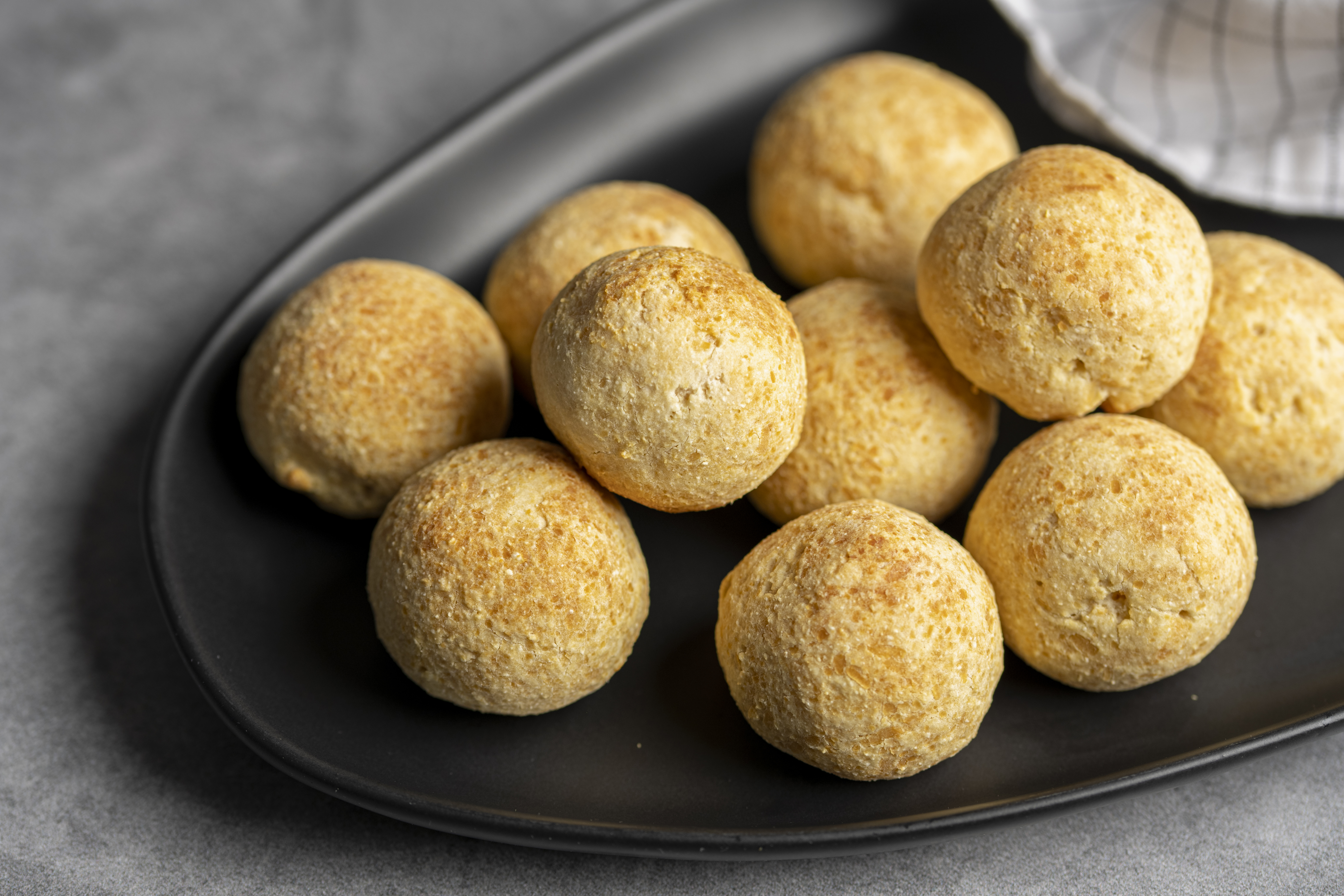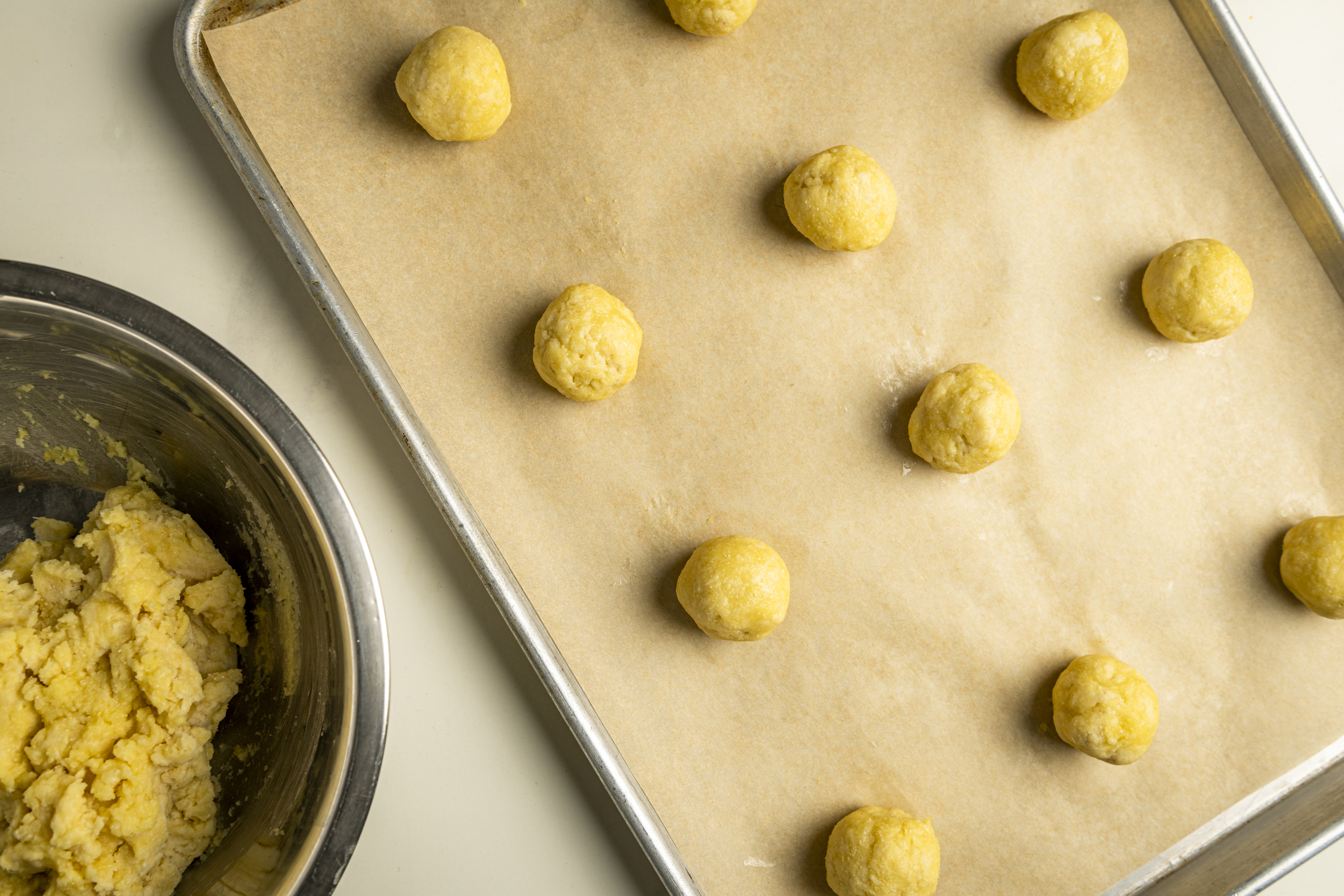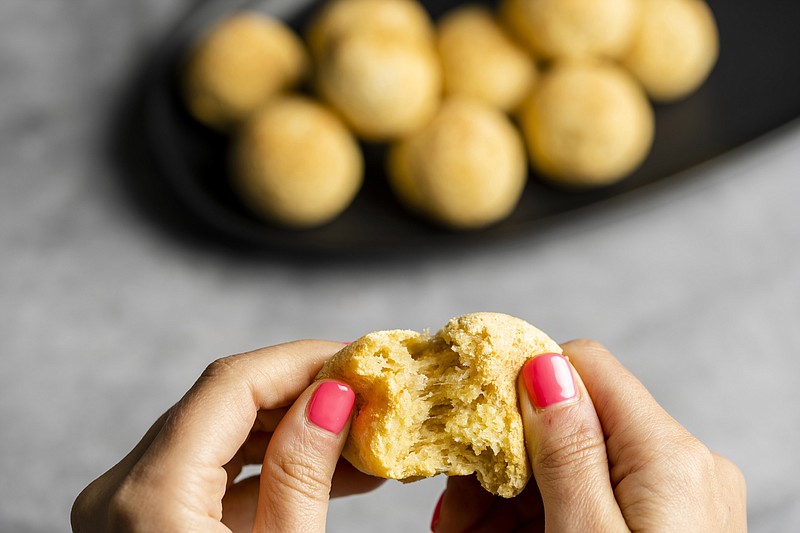I bake a lot of bread, but even I get tired of the common admonition to not eat it until it's completely cool. Sometimes you just want to tear into something hot and soft.
That's where this Pao de Queijo (spelled with a tilde over the a) recipe comes in. The gluten-free cheesy rolls that hail from Brazil are "wonderful to eat out of the oven," says chef Francisco Carvalho of Copacabana Brazilian Cuisine in Washington.
"When you cut one open, fresh from the oven, you see translucent starchy strands stretching between the two halves of your roll," writes Maricel E. Presilla in "Gran Cocina Latina: The Food of Latin America," the source of the recipe I'm sharing with you. Let the steam wash over your face, inhale the tang of the cheese and then tear into the sweet, chewy puffs. A rare moment of bliss in an increasingly unsettled world.
Anyone who has visited a Brazilian steakhouse in this country has likely come across pao de queijo served by the basket. In Brazil, they appear on tables throughout the day, in the morning with coffee or the evening with drinks. You may even find them filled with jam or more cheese. Carvalho says that sometimes when catering for children, he will cut them open and put a little meat and cheese inside for a tiny sandwich pocket.
If you're familiar with making French choux pastry for pao de queijo's cousin gougeres (as well as cream puffs and eclairs), the idea is somewhat similar but less fussy. First, you heat a mixture of butter, milk and salt. That gets stirred into the cassava flour, or yuca starch, after which you add cheese and a couple of eggs. Bring it together by hand, gently to keep the dough from tightening too much and ensure the cheese strands stay intact. Shape into balls and bake. That's it.
 Pao de Queijo out of the oven. (For The Washington Post/Peggy Cormary) The gluten-free cassava flour is an essential element of this recipe, but you have wiggle room with the cheese. Presilla uses parmesan (or Argentine sardo cheese), which is a pretty good stand-in for Brazilian queijo mineiro, a cheese native to the state of Minas Gerais, which lays claim to the creation of pao de queijo. Feel free to experiment with a cheese you like, though something on the firmer side with a salty edge is ideal. Carvalho recommends picking a cheese that can be easily shredded.
Pao de Queijo out of the oven. (For The Washington Post/Peggy Cormary) The gluten-free cassava flour is an essential element of this recipe, but you have wiggle room with the cheese. Presilla uses parmesan (or Argentine sardo cheese), which is a pretty good stand-in for Brazilian queijo mineiro, a cheese native to the state of Minas Gerais, which lays claim to the creation of pao de queijo. Feel free to experiment with a cheese you like, though something on the firmer side with a salty edge is ideal. Carvalho recommends picking a cheese that can be easily shredded.
Cassava flour is made from the tubular root of the cassava or yuca plant. The vegetable is similar in texture to a sweet potato but with a bark-like brown skin and fibrous white flesh. Look for cassava flour, sometimes called yuca starch, with the speciality flours or gluten-free foods at well-stocked grocery stores and specialty stores.
Pao de queijo are not a day-long project. Still, you'll want to leave yourself about 90 minutes from start to finish. You can, however, freeze partially baked puffs that you can pull out at a moment's notice to enjoy hot and fresh.
Pao de queijo are something you "make with love and time," Carvalho says. Both are well worth it.
Pao de Queijo
- 2 ¼ cups cassava flour (can also be labeled as yuca starch)
- 1 cup whole milk
- 4 tablespoons unsalted butter
- 1 teaspoon fine salt
- 2 large eggs, lightly beaten
- 2 cups finely grated parmesan cheese (can substitute any salty semihard cheese of your choice)
- Vegetable oil, for greasing your hands
Position a rack in the middle of the oven and heat to 450 degrees. Line two large, rimmed baking sheets with parchment paper.
Place the cassava flour in a large bowl.
In a small saucepan over medium heat, combine the milk, butter and salt and bring to a boil, stirring to melt the butter. Pour the milk mixture over the cassava flour and beat with a wooden spoon to combine. The dough will feel dense and will stiffen into a ball. At first it will look like it won't come together, but keep stirring, pressing and folding until it forms a single mass. Let cool for 15 minutes.
After the dough has mostly cooled (it may still be somewhat warm — that's OK), add the eggs and cheese to the bowl. While you can stir or fold with a wooden spoon, it's most effective to bring the dough together with your hands. Make sure the eggs and cheese are relatively well-distributed, but it doesn't have to be perfect. The more you handle or beat the dough, the more difficult it will be to shape.
Lightly oil the palms of your hands and pull off a 1-ounce portion of dough, approximately the size of a pingpong ball. Shape into a smooth sphere as best you can, repeating with all the dough, for a total of about 24 portions. As you work, place the dough balls on the lined baking sheets, 12 per pan. (They will spread but not dramatically.)
 Pao de Queijo on the baking sheet. The rolls spread during cooking but not much. (For The Washington Post/Peggy Cormary) Reduce the oven temperature to 375 degrees, and bake one sheet for 18 to 20 minutes, until the rolls are puffed and a rich golden color. (See note for instructions on partially baking and freezing to make ahead.) If you prefer a slightly crispier top, give them an additional 1 to 2 minutes, but keep an eye on them, as they can start to burn quickly. Before you bake the second batch, return the oven temperature to 450 degrees and then drop it to 375 once you start baking (the initial high temperature helps the rolls start to puff immediately).
Pao de Queijo on the baking sheet. The rolls spread during cooking but not much. (For The Washington Post/Peggy Cormary) Reduce the oven temperature to 375 degrees, and bake one sheet for 18 to 20 minutes, until the rolls are puffed and a rich golden color. (See note for instructions on partially baking and freezing to make ahead.) If you prefer a slightly crispier top, give them an additional 1 to 2 minutes, but keep an eye on them, as they can start to burn quickly. Before you bake the second batch, return the oven temperature to 450 degrees and then drop it to 375 once you start baking (the initial high temperature helps the rolls start to puff immediately).
Let the rolls cool for a few minutes on the pan, then serve hot or warm.
Makes about 24 small rolls.
Note: You can freeze partially baked pao de queijo. Bake them for half the time, about 10 minutes, and then let cool completely, about 30 minutes, before packing into an airtight container and freezing. To serve, bake at 375 degrees for 15 to 20 minutes (without defrosting) until puffed and deep golden.
Adapted from "Gran Cocina Latina: The Food of Latin America," by Maricel E. Presilla (W.W. Norton & Company, 2012)
Nutrition information: Each roll contains approximately 95 calories, 3 g protein, 4 g fat, 11 g carbohydrate (1 g sugar), 26 mg cholesterol, 151 mg sodium and no fiber.
Carbohydrate choices: 1
